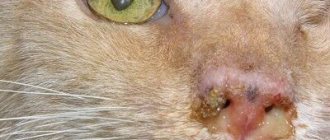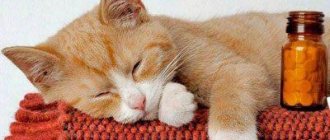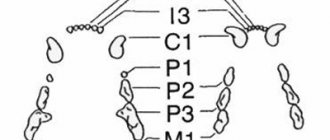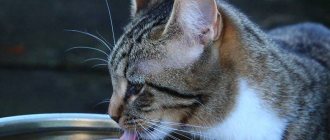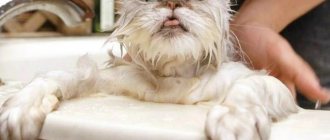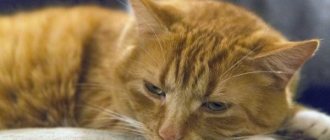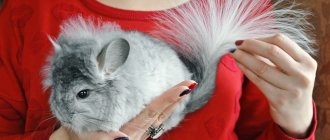Using home remedies for cleaning
Ideally, oral hygiene involves the use of special products designed for pets. But they are not always at hand.
At home, the procedure can be carried out using wine and soda. These products help remove food debris and stone formation.
First, the teeth are moistened with wine, then soda is applied. The components react with each other and purification occurs.
Necessary tools, materials
When choosing equipment, you need to take into account the pet's temperament. If the cat is calm and trusts its owner, then it will be possible to do without a brush. If the animal is aggressive and doesn’t like having fingers put in its mouth, you will have to choose non-contact hygiene products.
The first thing you need to do is choose a toothbrush.
There are two types of tools:
- fingertip;
- with a handle.
The fingertip makes it possible to completely control the cleaning process, but the pet can bite the owner. A brush equipped with a handle is considered safe.
It must be used carefully so as not to damage the animal’s gums.
A toothbrush that is intended for humans cannot be used for a cat, because the bristles on it are much stiffer and can scratch the delicate mucous membranes. As a last resort, you can use a baby brush . Its head is small and the bristles are much softer.
Cleaning is carried out with a special paste or simple tooth powder. The main thing is that the product does not have a strong smell or taste, otherwise the animal will not accept the procedure (cats do not like the smell of mint.
Cat hygiene products have a meat or fish aroma.
The process of brushing teeth at home
So, the cat is accustomed to periodic examination of the mouth and does not mind having its teeth touched. There is also everything needed to carry out the procedure. All that remains is to find out how to brush your cat’s teeth correctly.
| Master | Animal | |
| Step 1 | Wash your hands thoroughly with soap and treat them with an antiseptic. The assistant does the same. | Should have been fed at least two hours ago, particularly susceptible cats may be given a mild relaxant, agreed upon with your veterinarian. |
| Step 2 | He takes the cat on his lap, calms it, strokes it and talks to it. | The cat calms down and trusts its owner. |
| Step 3 | Armed with a brush onto which the paste is applied. | Carefully but firmly fixed by the owner or assistant. |
| Step 4 | With calm, not rough movements, it “sweeps” and “scrapes out” plaque from the teeth. Cleaning begins with the front teeth. Do not press too hard or move the brush across your teeth. | Going through the procedure. |
| Step 5 | If the procedure causes active opposition, it is better not to try to brush all the teeth at once. You can perform the procedure in two or three approaches. | Expects praise and treats. |
| Step 6 | Be sure to give your pet treats for trust and patience. | Receives some treat and clean teeth. |
If you already have plaque, you should treat your mouth every day. For prevention, once a week is enough.
Features of preparation
First you need to take your pet to the vet. The doctor will conduct an examination, give recommendations on the choice of hygiene products, and if caries is detected, he will clean it using ultrasound.
When preparing your pet for the procedure, you need to adhere to several rules:
- Introduce the cat to the brush and let him play with it a little.
- A few days before the scheduled procedure, offer to try the paste. The animal will get used to the new taste and will not be afraid during basic manipulations.
- Perform the procedure when the cat is fed, healthy and in a good mood.
- For the first time, it is better to use cotton swabs instead of a brush.
When to start teaching your kitten to brush his teeth?
It is not advisable to start brushing your kitten’s teeth until the baby teeth are completely replaced, which occurs at 7-8 months.
By this time, the pet has already grown so much that the size of the oral cavity allows the use of a toothbrush for hygiene.
Note! It is very difficult to accustom an adult to such a procedure if she has not been accustomed to it since childhood. In most cases, the animal begins to express dissatisfaction and show aggression towards the person. Therefore, after several unsuccessful attempts, the owner gives up, realizing that he is driving himself and his pet into a stressful situation.
Basic cleaning rules
To properly brush your pet’s teeth, you need to follow these recommendations:
- Perform actions without haste. Talk to the cat, stroke it.
- An aggressive animal should be wrapped in a towel and asked for someone to hold it.
- Use a separate brush for each cat.
- The duration of the procedure is a maximum of forty seconds.
- Excessive efforts should not be made. The actions are careful and unhurried, so as not to injure the animal.
- Manipulations need to be performed at the same time, this way it will be easier for the pet to get used to them.
Algorithm
Animal oral hygiene involves performing the following actions:
- Apply a little paste to the brush. The cat is placed between the legs (he should not see the owner or feel discomfort).
- One hand is placed on the pet's head. The index finger and thumb are at the corners of the mouth.
- Press on the area between the teeth - the animal will open its mouth. It is impossible to grab the lower jaw, moving it down.
- The upper lip is lifted with your fingers and cleaned on both sides.
- The brush is held at an angle of about 45⁰. Sweeping movements are performed from top to bottom. You cannot move horizontally.
- Gradually the mouth opens more. This way it is possible to get to the back teeth.
- The external and internal surfaces are cleaned. After this, proceed to the chewing part.
- Each side is cleared for ten seconds.
- It is necessary to ensure that the bristles do not get on the gums, otherwise they will begin to bleed.
- The gums are massaged with a special brush, movements are performed from top to bottom, then in a circle. Actions are soft and smooth.
- After finishing the basic manipulations, do not forget to praise your pet, stroke it, and give it a treat.
What you need for proper cleaning
The basic hygiene kit is a brush and toothpaste for cats. Human powders and pastes are toxic to animals and should not be used.
Types of toothbrushes for cats
A toothbrush for cats should be chosen with soft bristles, so the gums are less damaged. You can use a brush just like for people, just a smaller size.
The second option is finger brushes. They are made in the form of a cap that fits on the finger. Fingertips are available in 2 types: with bristles for cleaning and with pimples for massaging the gums. Usually sold as a set.
An alternative to a toothbrush for cats is gauze or a piece of bandage. The fabric is wrapped around the finger and the teeth are treated.
Toothpastes and gels
For oral hygiene, products are available in different forms:
- Classic toothpaste for cats.
Typically produced either with flavoring (chicken, beef) or unflavored. The product does not foam and can be swallowed. How much paste to add is indicated in each manufacturer's instructions.
- Liquid toothpaste for cats.
This is an option if mechanical cleaning cannot be carried out due to the cat’s “protest”. The product is dissolved in water that the pet drinks.
- Dental gels.
Features of brushing teeth in small kittens
It is necessary to teach hygiene procedures from an early age. The kitten first gets used to the fact that the owner holds his hands near his mouth. Then they begin to feed the baby by hand, gently touching the teeth.
When the kitten gets used to these actions, they begin to teach him to clean. In the first stages, the teeth are wiped with a damp cloth, performing smooth circular movements.
By four months, the animal calmly reacts to such manipulations.
At the age of four months, the child begins to learn to eat pasta. Squeeze the product onto your finger, let it smell and taste it.
After such an introduction, apply the paste to the brush and try to brush the front teeth. The processing area gradually increases. Next, cleaning is carried out as for adult cats.
Why is it necessary to brush your cat's teeth?
It is necessary to brush your cat's teeth to prevent plaque from forming on the surface of the teeth, which invariably leads to the formation of tartar. Plaque on teeth looks like a film on which there are pathogenic bacterial microorganisms that further contribute to the formation of a specific stone.
This is accompanied by increased bleeding of the gums, provoking the development of inflammatory processes, including gingivitis or periodontitis. The pet develops a repulsive, unpleasant odor from the mouth, and teeth may fall out.
According to statistics, 8 out of 10 cats, starting from the age of three, develop diseases in the oral cavity due to lack of hygiene. Therefore, it is necessary to accustom your pet to brushing its teeth from a very early age.
The remains of consumed food, when bacterial microflora joins, begin to form plaque, which usually accumulates on the outer surface of the teeth. On the inside, tartar forms less frequently.
In the future, tartar provokes irritation of the gums, causing inflammation and loss of teeth from their sockets. Pathogenic microorganisms pose a serious danger, being a source of infection in the body, they penetrate the systemic bloodstream. This threatens sepsis and serious complications for the body.
Each dental disease is characterized by a spectrum of specific symptoms. But there are also a number of general symptoms, such as an unpleasant odor from the mouth, hyperemia of the gums, discoloration of tooth enamel (dark brown and yellow deposits on the teeth), and increased secretion of salivary secretions.
At later stages of pathology development, the animal may exhibit other signs. The food that the cat takes may fall out during chewing, and the cat itself actively loses body weight because it cannot eat in sufficient quantities.
The danger is that, due to their natural characteristics, cats rarely show signs of the disease. Pets do not show signs of ill health for a long time, hiding the disease, so owners notice pathological changes when it is too late.
In this regard, veterinarians strongly recommend that especially older cats be regularly examined by specialists. During a preventive examination, the doctor will identify possible violations and take the necessary measures. The doctor will be able to remove the stone using modern technologies (ultrasonic cleaning), or using mechanical scraping.
The doctor will help you get rid of tartar, but without regular timely hygienic treatments it is not possible to get rid of plaque. The owner must thoroughly clean the surface of the teeth, gradually accustoming the pet to the procedure. It is recommended to accustom your cat to brushing its teeth from a very early age, so that in the future it does not cause rejection in the pet.
What to do if your pet resists
If an animal categorically refuses to perform hygiene procedures, you should not force it. Such actions are stressful for the cat .
It is recommended to select alternative cleaning options:
- Liquid paste. When used, the number of pathogenic microorganisms is reduced. The product is used according to the instructions: it is diluted with water (1 tsp of paste requires 1 glass of liquid), the resulting solution is added to drinking water. You should not use the product often because it can affect tooth enamel.
- Periodically replace soft food with dry food. They promote cleaning and massage the gums. Cats that constantly eat dry food should be given types that are designed to clean the mouth. Their granules have a unique structure and help remove plaque.
- It is recommended to give cartilage to pets that eat natural food (the consumption of tubular and flat bones is unacceptable). Raw meat is cut into pieces without chopping.
- You can purchase bones impregnated with an agent that prevents the formation of tartar.
- Special dental toys are purchased.
- You can add a small amount of toothpaste to food and apply it to toys.
- Use a spray that has an antibacterial effect. It is injected into the oral cavity after each meal.
Dental diseases in cats
Cats often have dental problems, and older pets are especially susceptible to this problem. In this case, caries rarely develops, more often - gingivitis and periodontitis.
There are various factors in the development of dental diseases. The most common ones are the following:
- poor nutrition;
- lack or improper care;
- hereditary factors;
- some infectious diseases.
The following symptoms indicate the presence of dental problems:
- bad breath;
- inflammation of the gums, redness;
- drooling (sometimes);
- change in natural color;
- deterioration of behavior – anxiety, aggression;
- loss of appetite, changes in the process of eating.
It is worth starting treatment for diseases as early as possible in order to avoid complications and restore the joy of life to your pet. Just like in humans, cats' teeth can hurt.
